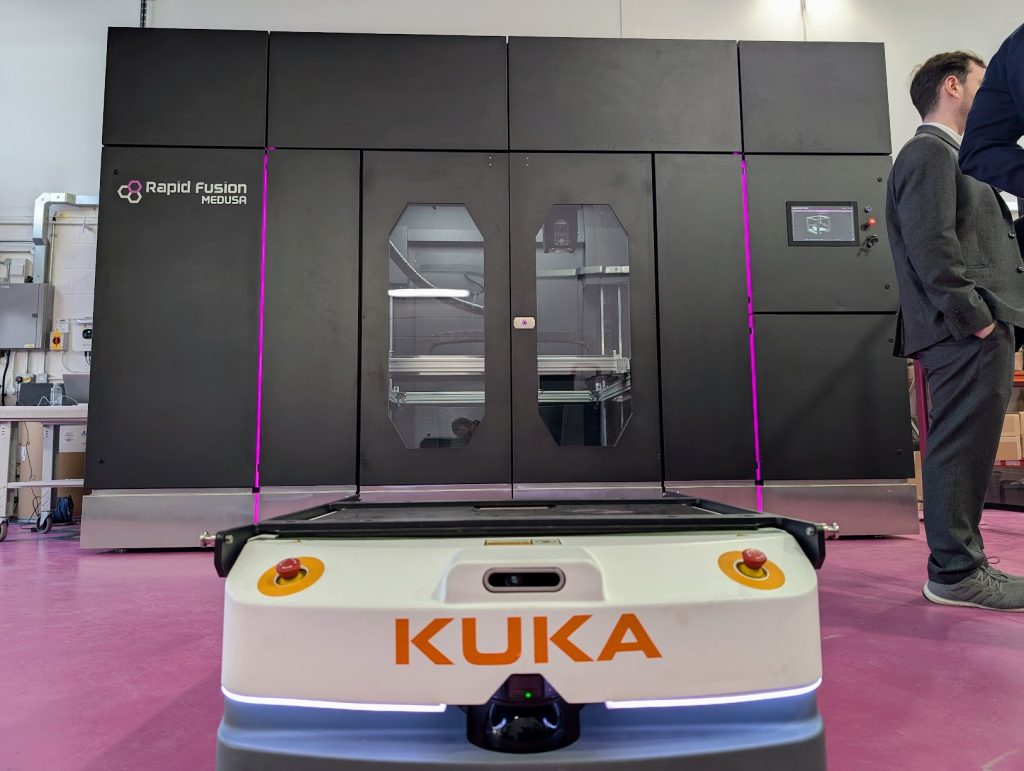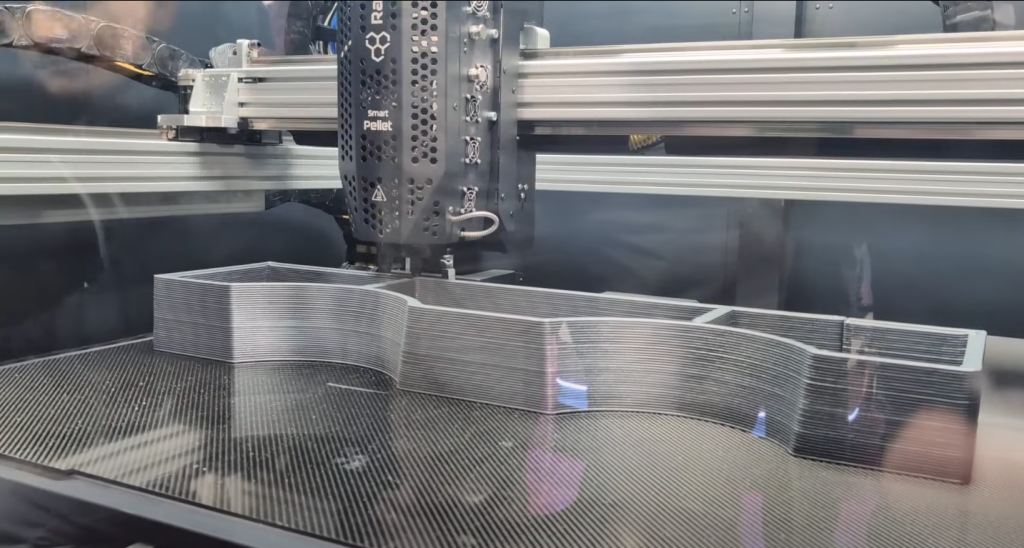It was a lively day at Rapid Fusion’s South West UK headquarters, where guests gathered under a marquee on an airstrip-adjacent site to witness a 3D printing first. Over conversation, coffee, and paella, co-founders Jake Hand and Martin Jewell introduced “Medusa,” a large-scale hybrid manufacturing system that merges high-speed material deposition with integrated CNC finishing. Developed over 18 months, Medusa aims to tackle challenges that have long confined additive manufacturing to prototyping rather than true production.
The launch is noteworthy for several reasons; companies are proceeding cautiously with CAPEX investments, creating a ripple effect across hardware sales, software, and services in AM. Rapid Fusion is well positioned to glean such insight, the company is a spin-out of Evo3D – a well-established 3D printer reseller with its offices and showroom above the workshop that now houses the first Medusa 3D printer, and also the Apollo platform: an earlier example of the high deposition pellet based 3D printing approach often referred to as Large Format Additive Manufacturing (LFAM).

From Concept to Prototype
Hand recalled how Medusa’s inception began, quite literally, “on the back of a [cigarette] packet.” Yet, in under two years, Rapid Fusion advanced the concept into a robust industrial prototype. CTO Martin Jewell explained that the team’s mission revolved around four key barriers blocking the mainstream adoption of additive manufacturing: “speed, scale, fragmented workflows, and reliability.”
“Medusa itself is not just another 3D printer,” Jewell said. “The one-click workflow and CNC finishing capabilities integrated within this system are transformational.” Medusa’s hefty 22-kilogram toolhead moves at speeds of up to 1.2 meters per second, depositing material at rates of 17 kilograms per hour. This performance stems from an industrial-strength chassis—“built like a literal tank,” as Jewell described it—ensuring stability even under rapid, heavy-payload movement.
Rapid Fusion has achieved this without VC funding and plans to stay agile, continuously iterating rather than sticking to rigid product cycles. They believe hardware-focused companies can suffer under VC expectations. “Other businesses release a product and then run it until nobody buys it anymore. We don’t operate that way,” said Jewell.
The company is also rapidly protecting intellectual property due to heightened competitor interest. Jewell said, “We had to file three patents this morning because we’re showing the technology today. Once it’s in the public domain, you lose the ability to file.” “Competitors have downloaded all the materials from our website in the last two weeks. It’s not ego; these are just facts,” added Hand.

Closing the Gap Between Additive and Subtractive
A standout feature of Medusa is its ability to combine additive and subtractive steps in a single automated workflow. The system integrates multiple printing heads for filament and pellet extrusion, as well as a CNC milling tool. Jewell stressed how this allows for seamless, no-hands transitions between printing and finishing, cutting lead times by around 60% compared to traditional processes.
He also highlighted the system’s advanced sensor suite and thermal visualization, which not only track real-time performance but will eventually enable predictive maintenance. “We’re looking at the long game,” Jewell said. “It’s about reliability, minimizing downtime, and upgrading machine intelligence over time.”
Medusa’s modular design further underscores its adaptability and ease of service. Critical components—including the machine’s “brain”—can be swapped or upgraded in about 45 minutes, reducing extended outages and future-proofing customer investments.
“You could essentially do a brain transplant on the machine in about 45 minutes,” Jewell explained. “It means you don’t need to replace the entire unit; you can upgrade components individually.”
Software Integration with AI Build
Rapid Fusion’s hardware breakthroughs dovetail with automation-driven software provided by AI Build, a London-based company specializing in software for AM and hybrid manufacturing. Guy Brown, Head of R&D at AI Build, underscored the importance of a unified platform that spans every stage of manufacturing, from uploading design files to real-time process monitoring.
“We’ve been printing in the lab for 10 years, and we’ve had a lot of failures,” Brown said. “All that pain has been turned into lessons learned and baked into our software.”
AI Build’s platform automatically checks designs for additive manufacturing suitability, slices and simulates the toolpaths, and oversees process control. The system also introduces “hybrid toolpathing,” enabling subtractive steps—trimming or smoothing just a few millimeters—in the same environment. This approach delivers high-quality surface finishes comparable to more complex multi-axis milling machines.
Moreover, AI Build created a digital twin of the Medusa system to ensure collision detection and safe operations. A tailored post-processor handles tool-change macros that let customers easily calibrate their machines. Brown also highlighted AI Build’s starter software, featuring a “one-click” slicing interface with nine preconfigured strategies. This simplified approach lowers the barrier to entry for those transitioning from smaller desktop 3D printers.
“This helps users reach their first print as fast as possible,” he noted. “It’s about streamlining that learning curve so you can go from zero to functional part in a fraction of the usual time.”
“There’s nobody in a factory setting thinking, ‘I want a robot that prints.’ They think, ‘I want to make a mold—what are my options?’ So they talk to their integrators,” said Hand. Traditional robot integrators and manufacturers, like ABB, KUKA, FANUC, are slowly recognizing large-format printing’s potential. FANUC is more open; KUKA and ABB are cautious.
Thermal Shield and Real-Time Monitoring
AI Build’s Thermal Shield is a key software innovation, an infrared camera-based monitoring feature that checks interlayer temperatures during printing. The system automatically adjusts print settings to maintain optimal thermal conditions, preventing layers from overheating or cooling too rapidly.
“Thermal monitoring brings down the barrier to entry dramatically,” Brown said, emphasizing how newer operators might miss subtle temperature cues an experienced operator would catch. The technology also logs comprehensive process data, enabling traceability vital for aerospace, automotive, and other sectors that demand rigorous quality control.
Rapid Fusion envisions self-optimizing machines via on-prem AI, but data-sharing hurdles remain. They aim to integrate NVIDIA modules for localized machine learning without exposing sensitive data. “We’ve built the hardware infrastructure to enable AI-driven printing… The next step is for it to adjust the process automatically,” said Jewell.

De-Risking Through Simulation and Compliance
The National Manufacturing Institute Scotland (NMIS) provided crucial input for Medusa’s development, focusing on simulation, risk assessment, and regulatory compliance. Dickon Walker, an R&D engineer at NMIS, explained that his team coordinated an industry steering group to gather real-world feedback, ensuring the printer’s design aligned with genuine production scenarios.
NMIS conducted finite element analysis (FEA) to assess structural stability under Medusa’s high-speed, heavy-load conditions. Minor deviations—less than one millimeter across a large build volume—were uncovered through laser trackers and optical coordinate measuring systems. While small, these deviations still prompted hardware refinements.
“We simulated how the printer frame behaves when driving such a heavy tool at high speeds,” Walker said. “Though the deviations were under one millimeter, we aimed to refine alignment further.”
Beyond structural testing, NMIS managed CE marking guidelines, essential for market acceptance. Walker acknowledged that preparing technical files is “not the sexiest part of engineering” but remains critical for commercializing the machine. NMIS also validated mechanical properties by printing test samples on Medusa rather than relying on generic datasheets, which often reflect injection-molded rather than 3D-printed characteristics.
Sustainable Materials With Filamentive
Ravi Toor, founder and director of Filamentive, underscored the sustainability aspect of the Medusa project. While additive manufacturing is considered inherently less wasteful than subtractive processes, Toor cautioned against overlooking plastic consumption and end-of-life recycling.
Pellet-based printing—one of Medusa’s capabilities—eliminates spool waste and requires less energy than producing filament. The approach also encourages the use of locally sourced recycled materials, further cutting carbon footprints. In parallel, Medusa’s filament extruder allows high-detail prints and access to a broader array of materials.
“We can’t ignore plastic consumption or recycling at the end of life,” Toor noted. “Pellet-based printing cuts waste from spools and reduces energy usage, while also making it easier to integrate recycled feedstock.”
Filamentive tested polymer blends such as recycled PETG or polycarbonate reinforced with glass fiber, achieving heat resistance above 100 degrees Celsius. Some of these blends reduce carbon emissions by up to 60% compared to virgin materials. Toor also praised Medusa’s modularity, which lets users replace only faulty components—like the heated bed or extruder—rather than discarding the entire machine.
On the decision to use open materials and pelletised feedstock Hand said, “Charging £200 to £300 for a kilo of PLA? It’s insane. It’s just the business model—keeping customers locked in… We’re more focused on delivering the best solution, making a profit, and not exploiting the buyer.” Rapid Fusion rejects “closed” systems and high material markups that trap users into overpriced consumables. They view this as a barrier to mainstream adoption.
Backing from Innovate UK
Chaco van der Sijp, Innovation Lead at Innovate UK, likened attending Medusa’s launch to “a parent at a child’s graduation.” Innovate UK, the UK’s innovation agency, provided funding and strategic guidance, helping Rapid Fusion, AI Build, Filamentive, and NMIS iterate quickly and minimize risk.
“We’re extremely thrilled with how this has panned out,” said van der Sijp. “Scaling large-format is a bold move, but we’re going to get there one day.”
He noted that additive manufacturing still faces skepticism regarding scalability and automation’s potential impact on employment. Innovate UK’s stance is that automation, when done correctly, fosters new high-level jobs.
Van der Sijp highlighted Medusa’s integrated approach—covering material sourcing, design, supply chain management, fabrication, and circular reuse—as key to genuine transformation. By addressing the entire manufacturing ecosystem, Medusa aims to push additive technologies closer to a mainstream, globally recognized manufacturing solution.
A Glimpse into the Future of Additive Manufacturing
From the robust build of its chassis to the advanced software stack that orchestrates both printing and CNC finishing, Medusa represents a comprehensive step forward in industrial 3D printing. The collaboration between Rapid Fusion, AI Build, NMIS, Filamentive, and Innovate UK underscores a united push to overcome long-standing hurdles—speed, scale, workflow integration, reliability, and sustainability.
Rapid Fusion pegs the large-format market’s annual TAM at £15–20 million. They see themselves among the top three global players, aiming to expand demand rather than battle for a small pie.
If the excitement at Rapid Fusion’s unveiling is any indication, Medusa may well represent an important moment for additive manufacturing in the UK, closing the gap between prototype-friendly 3D printers and the reliable, scalable systems that industries have long demanded.
Subscribe to the 3D Printing Industry newsletter to keep up with the latest 3D printing news.
You can also follow us on LinkedIn and subscribe to the 3D Printing Industry Youtube channel to access more exclusive content.
Featured image shows the Rapid Fusion Medusa launch. Photo by Michael Petch.



